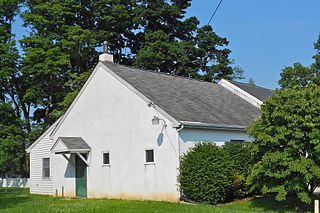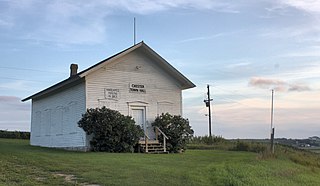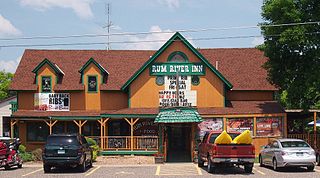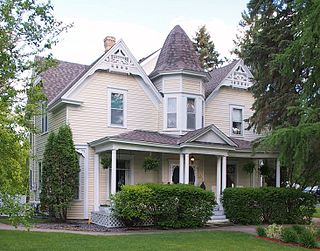
Anoka County is the fourth-most populous county in the U.S. state of Minnesota. As of the 2020 census, its population was 363,887. The county seat and namesake of the county is the city of Anoka, which is derived from the Dakota word anokatanhan meaning "on both sides", referring to its location on the banks of the Rum River. The largest city in the county is Blaine, the thirteenth-largest city in Minnesota and the eighth-largest Twin Cities suburb.

Linwood Township is a township in Anoka County, Minnesota, United States. The population was 5,123 at the 2010 census. The township contains the census-designated place of Martin Lake and the unincorporated village of Linwood. Linwood Township is the only area of Anoka County that is not an incorporated city.

The Grange, officially named The National Grange of the Order of Patrons of Husbandry, is a social organization in the United States that encourages families to band together to promote the economic and political well-being of the community and agriculture. The Grange, founded after the Civil War in 1867, is the oldest American agricultural advocacy group with a national scope. The Grange actively lobbied state legislatures and Congress for political goals, such as the Granger Laws to lower rates charged by railroads, and rural free mail delivery by the Post Office.

Oliver Hudson Kelley was one of the key founders of the National Grange of the Order of Patrons of Husbandry, a fraternal organization in the United States.

This is a list of sites in Minnesota which are included in the National Register of Historic Places. There are more than 1,700 properties and historic districts listed on the NRHP; each of Minnesota's 87 counties has at least 2 listings. Twenty-two sites are also National Historic Landmarks.

The Oliver Kelley Farm is a farm museum in Elk River, Minnesota, United States. From 1850 to 1870 it was owned by Oliver Hudson Kelley, one of the founders of the National Grange of the Order of Patrons of Husbandry, the country's first national agrarian advocacy group. The Oliver Kelley Farm is operated as a historic site by the Minnesota Historical Society. It was declared a National Historic Landmark in 1964 under the name Oliver H. Kelley Homestead—which also places it on the National Register of Historic Places—for its national significance in the themes of agriculture and social history. It was nominated as a representative of the beginnings of agrarian activism in the United States, setting the stage for the Farmers' Alliance and the People's Party of the late 19th century.

Minnehaha Grange, No. 398 was organized on December 23, 1873, with members from Edina Mills, Richfield Mills, St. Louis Park, and Hopkins. The National Grange of the Order of Patrons of Husbandry, commonly known as the Grange, is an organization dedicated to the principles of "progressive agriculture" for the "social fraternity of the farmers". The organization was founded in 1867 by Oliver Hudson Kelley in Elk River, Sherburne County, Minnesota and quickly spread across the country. The fraternity tackled issues such as railroad prices, and providing education to farmers.

Ercildoun, population about 100, is an unincorporated community in East Fallowfield Township, Chester County, Pennsylvania, United States. The hamlet was founded by Quakers and was an early center of the abolitionist movement. In 1985 the entire hamlet, including 31 properties, was listed as a historic district on the National Register of Historic Places. Of these properties two were vacant land, 14 were significant buildings, ten were contributing buildings, and five buildings, built in the 1950s, were non-contributing. The Lukens Pierce House, an octagon house listed separately on the U.S. National Register of Historic Places, is located about half a mile northwest of the hamlet. Ercildoun is one of about ten hamlets in the township, which has no cities or towns, but has 31 sites listed on the National Register. It is one of the larger hamlets, located near the center of the township, and historically among the best known. The city of Coatesville is about 3 miles north.

This is a list of the National Register of Historic Places listings in Anoka County, Minnesota. It is intended to be a complete list of the properties and districts on the National Register of Historic Places in Anoka County, Minnesota, United States. The locations of National Register properties and districts for which the latitude and longitude coordinates are included below, may be seen in an online map.

The Grange Hall in Somerset Township, Jackson County, Illinois, is the historic meeting place of Somerset Township's chapter of The Grange. Built in 1912, the building was Somerset Grange #1553's second meeting hall; the first building was built in 1876 and burned down in 1909. The red brick building was built by contractor W. A. Pitman in the Commercial style. The Grange Hall served as a meeting place for local farmers to discuss agricultural affairs and propose farm policy to legislators. The National Farmers Union's newspaper, the Union Farmer, was published from the Somerset Grange Hall until 1914. The building also served as a local social center and hosted township elections, club meetings, and community events. The hall was rehabilitated in 1988; it still serves as a township polling place.

The Bear Valley Grange Hall is a historic meeting hall in Chester Township, Minnesota, United States. It was built in 1874 for the exclusive use of a local chapter of the National Grange of the Order of Patrons of Husbandry, an early farmers' advocacy group and fraternal organization. The chapter folded in the 1880s and the building has been used since as the Chester Town Hall. It was listed on the National Register of Historic Places in 1989 for having local significance in the theme of social history. It was nominated for being the only surviving Grange hall in Wabasha County—and one of only a few in Minnesota—and a rare example of a purpose-built Grange hall, as most chapters met in existing spaces like schools.

The Banfill Tavern, also known as the Locke House, is a historic building in Fridley, Minnesota, United States. It was built in 1847 on the east bank of the Mississippi River and has served variously as an inn, a logging camp office, a private home, a dairy farm, a post office, and a summer home. It is now owned by Anoka County and, until April 2022, housed the non-profit Banfill-Locke Center for the Arts. The building stands within Manomin County Park, and the art center is a partner site of the Mississippi National River and Recreation Area.

Ada Village Hall is the former center for local government in Ada, Minnesota, United States. Completed in 1904, it was also an important public meeting hall and social facility through the 1970s. Architecturally, the building is an excellent example of the combined city hall and fire hall buildings that were constructed in Minnesota during the early 20th century. It was listed on the National Register of Historic Places for having local significance to politics/government and social history.

The Jefferson Grain Warehouse is a historic warehouse in Jefferson Township, Minnesota, United States, built in 1868 on the bank of the Mississippi River. The warehouse was listed on the National Register of Historic Places in 1994 for having local significance in the themes of commerce and transportation. It was nominated for being a rare surviving reminder of a brief period when wheat was becoming the most important agricultural crop of the Upper Midwest yet steamboats were still the leading form of transportation.
Lodge Boleslav Jablonsky No. 219 is the meeting hall of a Czech American fraternal society in Poplar Grove Township, Minnesota, United States. The hall was built in 1916 and remains in use as of 2016. It was listed on the National Register of Historic Places in 2002 for having local significance in the themes of European ethnic heritage and social history. It was nominated for being a representative of ethnic history in the last part of Minnesota to be settled by Euro-Americans.

The Clarks Grove Cooperative Creamery is a historic creamery in Clarks Grove, Minnesota, United States. It was established in 1890 as one of the first cooperative creameries in Minnesota. The Clarks Grove Cooperative Creamery used new technology and a well-organized cooperative system. It became a model for the Minnesota dairy industry. Ten years later, there were more than 550 cooperative creameries in the state.
The Swede Prairie Progressive Farmers' Club, also known as Roberg Hall, was a 1915 meeting hall of a local farmers' organization in Swede Prairie Township, Yellow Medicine County, Minnesota, United States, which became the township hall. It was listed on the National Register of Historic Places in 1986 as a rare physical reminder of the grassroots agricultural movements of the early 20th century.

The Riverside Hotel is a historic former hotel in St. Francis, Minnesota, United States. It was originally built around 1860 as a residence, then expanded into a hotel beginning in 1891. This period spanned the heyday of the local lumber industry that urbanized present-day Anoka County, Minnesota. The property was listed on the National Register of Historic Places in 1979 for its local significance in the theme of commerce. It was nominated for being the only surviving commercial building dating to St. Francis's settlement as a lumber boomtown, and its association with the Woodbury family that helped found St. Francis and Anoka, Minnesota.

The H. G. Leathers House is a historic house in St. Francis, Minnesota, United States. It was originally built on a site near the Rum River around 1883. Around 1890 it was moved closer to the river and expanded. The property was listed on the National Register of Historic Places in 1979 for its local significance in the themes of architecture and commerce. It was nominated for its association with three generations of an influential local family, and for its status as one of Anoka County's few Victorian houses.






















